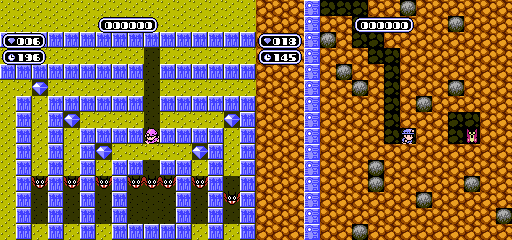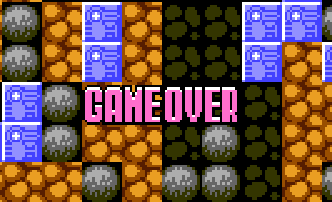I think what I like about good action puzzle games is that they an take a simple concept and spiral it wildly from that centre. You maintain the core attributes of the game, while providing many varied experiences by branching off from it. And a puzzle game can attain this quality by simply moving pieces, introducing a single new element, or even by changing where the player starts. Modern or classic, they’re a very “pure” style of game. My prime example is always Eggerland, but there are many others of course. And when I am turned on to another, I really have to hunt it down.

Enter Boulder Dash.. Created by Peter Liepa and Chris Gray it shares elements with The Pit, and even other digging games like Mr. Do! or Dig Dug. Of course, it is also entirely its own animal with a myriad of releases each varying wildly aesthetically. This is a hard game to pin down a definitive version, because I’d wager anyone’s definitive version is either the first they’ve played or have discerned through years of play.

Either way, one point stands – Boulder Dash is solid. It’s exciting, logical, and fast-paced.
The concept is simple: You control Rockford as you dig through caves searching for diamonds. Collecting a quota of diamonds will open the exit somewhere in the caves, though you can of course try to collect more if they are available for points. The titular boulders are held up by the soil you dig through. Digging through the soil beneath them causes them to fall. A falling boulder can kill Rockford or any other creature it connects with. It can also block a critical path, so you must analyze each situation. Furthermore, a rock sitting on top of another rock or on top of undiggable ground will roll when there is space free to the side and beneath this side space. This includes diamonds, so rocks or diamonds landing on one another will “topple.”

There are enemies in the caves as well. Most of them follow a set path. Hitting them with a rock will generally cause them to explode in a 3×3 blast. Some, but not all, enemy types produce a 3×3 square of diamonds when they are killed and Rockford is often required to kill them to complete the level. Others simply explode but you may need to clear them out of a path or use them to explode a wall to get at the diamonds behind. There are also some environmental factors. You can figure out the amoebas and magic walls all by your lonesome!

The game is 6 worlds long, with 4 loops if I’m remembering correctly. Each world has four levels, and you must beat a world on a single continue. At least in this NES version, you can select the order of a world’s stages. So once you have solved each of them, you can start on the hardest and work your way towards the easier finish so it’s not so bad. New loops of the game add stricter diamond quotas and tighter time limits. I haven’t played through every loop, but this is a game I will be returning to again and again.
It’s the mix of elements that make Boulder Dash a joy to play the whole way through. Every level is different. The experience changes so much with the topography. Some levels have you making meticulous moves to facilitate an endgame. Others have you making bold and speedy moves as rocks crash down to fill the voids behind you. There’s enough variety to keep the whole game fresh and even make concurrent playthroughs attractive. And this spun out from the simple concept of collecting diamonds and avoiding rocks.

This is the kind of stuff I eat right up. You can see three moves ahead, but you need to figure out those three moves to make it there. That’s what I love about these games. They unravel before your eyes and everything feels right when it all comes together.
Of course, Boulder Dash is not for folks who are quick to anger. It does have a bit of a learning curve, but once you get that you’re golden. If you enjoy digging games from this era, or action puzzle games from this era then I urge you to find a copy of this. It’s very much a cause and effect game, a perfect match for puzzlers who like to think on their feet. Just don’t get crushed!


You have a blogging phase of action puzzle games that I’ve either played only a little of or not at all. This one is the former, again. 😛
Don’t do Fire ‘N Ice or Solomon’s Key next. 😉 Of course, kidding! I enjoy the articles nevertheless.
Yeah, this is something enthusiasts of the genre should like. For some reason I though this game looked like the right picture of ‘Enemies’ the whole game and didn’t have varied enviroments. I’ll have to try this more extensively.
It’s sort of funny how something as simple as a couple of tile changes can keep a game thematically interesting.
Solomon’s Key I’m still working on beating every now and then. I made it 30 rooms in before my NES crapped out. Fire ‘N Ice… I wish. That game is pretty expensive so I wouldn’t have a copy to take a picture of :P.
Indeed.
Ah… that sucks! The NES was never the most reliable console and age doesn’t help. I see.
Dang, I missed this one completely in the pre-xmas rush! 🙁 Weird thing is, don’t thinkl I ever played this before. One way or another, I’ve tried damn near everything that came out on NES 😛 P.S. Nice Rocklords, I recognise Nugget, but is that Slimestone with him? When did you rock him?? 🙂